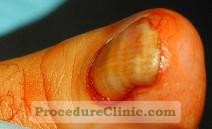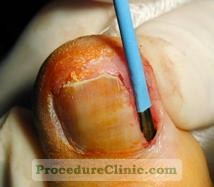Nail Diseases

Your toenails and fingernails protect the tissues of your toes and fingers. They are made up of layers of a hardened protein called keratin, which is also in your hair and skin. Your nails' health can be a clue to your overall health. Healthy nails are usually smooth and consistent in color. Specific types of nail discoloration and changes in growth rate can signal various lung, heart, kidney and liver diseases, as well as diabetes and anemia. White spots and vertical ridges are harmless.
Nail problems that sometimes require treatment include bacterial and fungal infections, ingrown nails, tumors and warts. Keeping nails clean, dry and trimmed can help you avoid some problems. Do not remove the cuticle, which can cause infection.
Ingrown Toenails
Ingrown nails, the most common nail impairment, are nails whose corners or sides dig painfully into the soft tissue of nail grooves, often leading to irritation, redness, and swelling. Usually, toenails grow straight out. Sometimes, however, one or both corners or sides curve and grow into the flesh. The big toe is usually the victim of this condition but other toes can also become affected.
Ingrown toenails may be caused by:
- Improperly trimmed nails
- Heredity
- Shoe pressure; crowding of toes
- Repeated trauma to the feet from normal activities
If you suspect an infection due to an ingrown toenail, immerse the foot in a warm salt water soak, or a basin of soapy water, then apply an antiseptic and bandage the area.
People with diabetes, peripheral vascular disease, or other circulatory disorders must avoid any form of self treatment and seek medical care as soon as possible.
Other "do-it-yourself" treatments, including any attempt to remove any part of an infected nail or the use of over-the-counter medications, should be avoided. Nail problems should be evaluated and treated by your doctor, who can diagnose the ailment, and then prescribe medication or another appropriate treatment.
Your doctor will resect the ingrown portion of the nail and may prescribe a topical or oral medication to treat the infection. If ingrown nails are a chronic problem, your doctor can perform a procedure to permanently prevent ingrown nails. The corner of the nail that ingrows, along with the matrix or root of that piece of nail, are removed by use of a chemical, a laser, or by other methods.
Fungal infection of the nail, or onychomycosis, is often ignored because the infection can be present for years without causing any pain. The disease is characterized by a progressive change in a toenail's quality and color, which is often ugly and embarrassing.
In reality, the condition is an infection underneath the surface of the nail caused by fungi. When the tiny organisms take hold, the nail often becomes darker in color and foul smelling. Debris may collect beneath the nail plate, white marks frequently appear on the nail plate, and the infection is capable of spreading to other toenails, the skin, or even the fingernails. If ignored, the infection can spread and possibly impair one's ability to work or even walk. This happens because the resulting thicker nails are difficult to trim and make walking painful when wearing shoes. Onychomycosis can also be accompanied by a secondary bacterial or yeast infection in or about the nail plate.
Prevention
- Proper hygiene and regular inspection of the feet and toes are the first lines of defense against fungal nails.
- Clean and dry feet resist disease.
- Washing the feet with soap and water, remembering to dry thoroughly, is the best way to prevent an infection.
- Shower shoes should be worn when possible in public areas.
- Shoes, socks, or hosiery should be changed more than once daily.
- Toenails should be clipped straight across so that the nail does not extend beyond the tip of the toe.
- Wear shoes that fit well and are made of materials that breathe.
- Avoid wearing excessively tight hosiery, which promote moisture.
- Socks made of synthetic fiber tend to "wick" away moisture faster than cotton or wool socks.
- Disinfect instruments used to cut nails.
- Disinfect home pedicure tools.
- Don't apply polish to nails suspected of infection—those that are red, discolored, or swollen, for example.
Treatment of Fungal Nails

Your doctor can detect a fungal infection early, culture the nail, determine the cause, and form a suitable treatment plan, which may include prescribing medications, debridement or removal of an infected nail, and laser treatment.
10 minutes laser treatment will change your life. It is safe and without major discomfort. Recent clinical studies showed about 87% effective rate with laser treatment of the nail fungus, much higher effective rate than the oral medications. Since toenail fungus laser treatment is drug-free, there are none of the potential major risks and possible liver damage associated with the oral medications.
Nail Care Tips
- Proper hygiene and regular inspection of the feet and toes are the first lines of defense against fungal nails.
- Clean and dry feet resist disease.
- Washing the feet with soap and water, remembering to dry thoroughly, is the best way to prevent an infection.
- Shower shoes should be worn when possible in public areas.
- Shoes, socks, or hosiery should be changed more than once daily.
- Toenails should be clipped straight across so that the nail does not extend beyond the tip of the toe.
- Wear shoes that fit well and are made of materials that breathe.
- Avoid wearing excessively tight hosiery, which promote moisture.
- Socks made of synthetic fiber tend to "wick" away moisture faster than cotton or wool socks.
- Disinfect instruments used to cut nails.
- Disinfect home pedicure tools.
- Don't apply polish to nails suspected of infection—those that are red, discolored, or swollen, for example.

